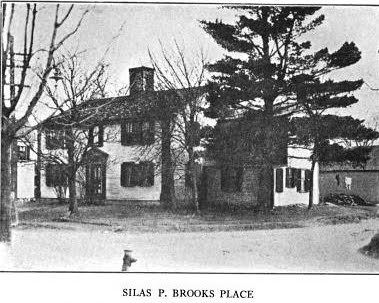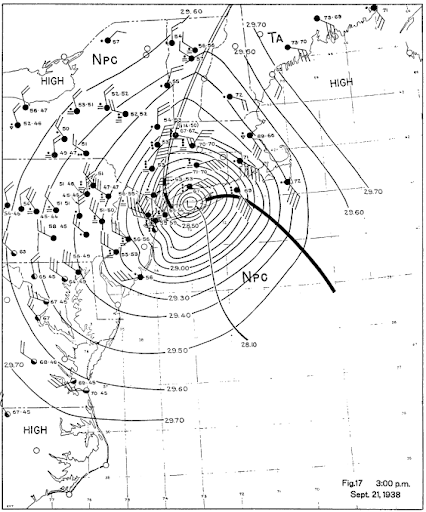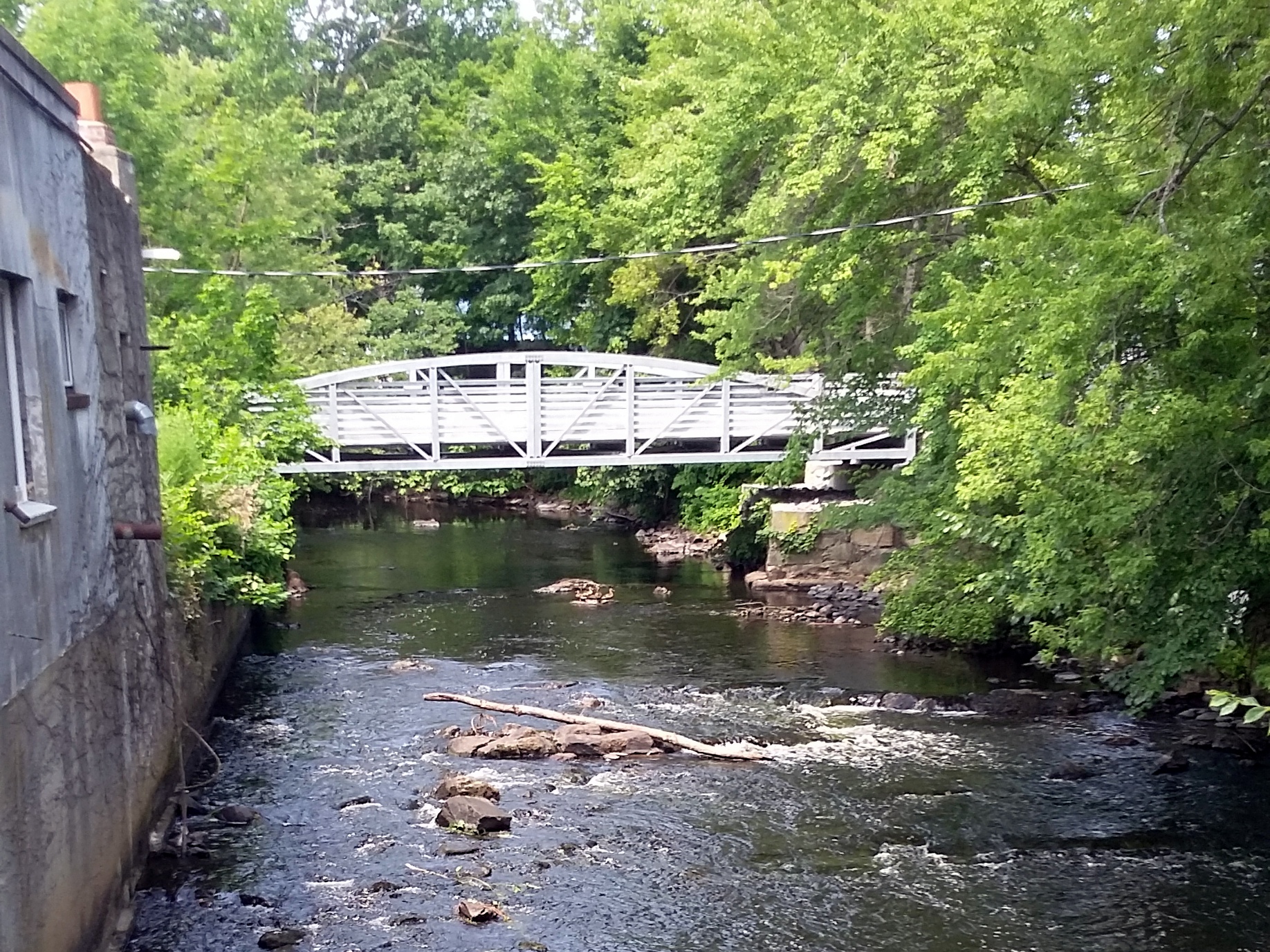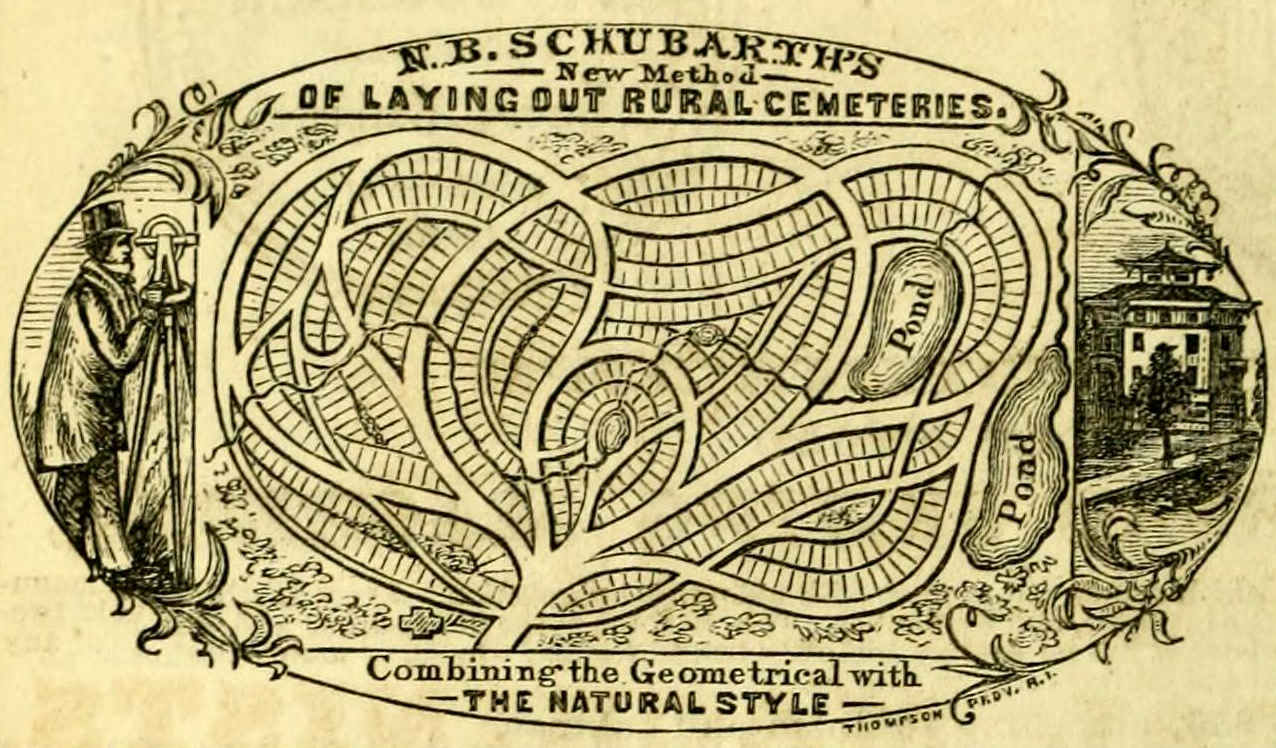|
Glenwood Cemetery (Maynard, Massachusetts)
Glenwood Cemetery is a historic rural cemetery northeast of Parker Street and Great Road in Maynard, Massachusetts. It is one of the first municipal creations of the town after its incorporation in 1871, and is the resting place of many of its early and prominent residents, including Amory Maynard, founder of the Assabet Woolen Mill and namesake of the community. The cemetery was added to the National Register of Historic Places (NR#04000425) on May 12, 2004. Description and history Glenwood Cemetery is located at the northeast corner of Parker Street (Massachusetts Route 27) and Great Road (Massachusetts Route 117), a short way south of the town center. It has entrance is on Great Road, roughly midway between Parker Street and Old Mill Road, and on Parker Street, nearly opposite Walker Street. The cemetery has two distinct sections, reflecting its growth over time. The oldest portion of the cemetery is in size, and was purchased by the town in 1871, the year of its incorpo ... [...More Info...] [...Related Items...] OR: [Wikipedia] [Google] [Baidu] |
Maynard, Massachusetts
Maynard is a town in Middlesex County, Massachusetts, United States. The town is located 22 miles west of Boston, in the MetroWest and Greater Boston region of Massachusetts and borders Acton, Concord, Stow and Sudbury. The town's population was 10,746 as of the 2020 United States Census. Maynard is located on the Assabet River, a tributary of the Concord River. A large part of the Assabet River National Wildlife Refuge is located within the town, and the Assabet River Rail Trail connects the Refuge and downtown Maynard to the South Acton commuter rail station. Historic downtown Maynard is home to many shops, restaurants, galleries, a movie theater, and the former Assabet Woolen Mill, which produced wool fabrics from 1846 to 1950, including cloth for Union Army uniforms during the Civil War. Maynard was the headquarters for Digital Equipment Corporation from 1957 to 1998. Owners of the former mill complex currently lease space to office and light-industry businesses. History ... [...More Info...] [...Related Items...] OR: [Wikipedia] [Google] [Baidu] |
New England Hurricane Of 1938
The 1938 New England Hurricane (also referred to as the Great New England Hurricane and the Long Island Express Hurricane) was one of the deadliest and most destructive tropical cyclones to strike Long Island, New York, and New England. The storm formed near the coast of Africa on September 9, becoming a Category 5 hurricane on the Saffir–Simpson hurricane scale, before making landfall as a Category 3 hurricane on Long Island on Wednesday, September 21. It is estimated that the hurricane killed 682 people, damaged or destroyed more than 57,000 homes, and caused property losses estimated at $306 million ($4.7 billion in 2017). Multiple other sources, however, mention that the 1938 hurricane might have really been a more powerful Category 4, having winds similar to Hurricanes Hugo, Harvey, Frederic and Gracie when it ran through Long Island and New England. Also, numerous others estimate the real damage between $347 million and almost $410 million. Damaged trees and buildings w ... [...More Info...] [...Related Items...] OR: [Wikipedia] [Google] [Baidu] |
Cemeteries In Middlesex County, Massachusetts
A cemetery, burial ground, gravesite or graveyard is a place where the remains of dead people are buried or otherwise interred. The word ''cemetery'' (from Greek , "sleeping place") implies that the land is specifically designated as a burial ground and originally applied to the Roman catacombs. The term ''graveyard'' is often used interchangeably with cemetery, but a graveyard primarily refers to a burial ground within a churchyard. The intact or cremated remains of people may be interred in a grave, commonly referred to as burial, or in a tomb, an "above-ground grave" (resembling a sarcophagus), a mausoleum, columbarium, niche, or other edifice. In Western cultures, funeral ceremonies are often observed in cemeteries. These ceremonies or rites of passage differ according to cultural practices and religious beliefs. Modern cemeteries often include crematoria, and some grounds previously used for both, continue as crematoria as a principal use long after the interment areas ... [...More Info...] [...Related Items...] OR: [Wikipedia] [Google] [Baidu] |
Cemeteries On The National Register Of Historic Places In Massachusetts
A cemetery, burial ground, gravesite or graveyard is a place where the remains of dead people are buried or otherwise interred. The word ''cemetery'' (from Greek , "sleeping place") implies that the land is specifically designated as a burial ground and originally applied to the Roman catacombs. The term ''graveyard'' is often used interchangeably with cemetery, but a graveyard primarily refers to a burial ground within a churchyard. The intact or cremated remains of people may be interred in a grave, commonly referred to as burial, or in a tomb, an "above-ground grave" (resembling a sarcophagus), a mausoleum, columbarium, niche, or other edifice. In Western cultures, funeral ceremonies are often observed in cemeteries. These ceremonies or rites of passage differ according to cultural practices and religious beliefs. Modern cemeteries often include crematoria, and some grounds previously used for both, continue as crematoria as a principal use long after the interment areas ... [...More Info...] [...Related Items...] OR: [Wikipedia] [Google] [Baidu] |
National Register Of Historic Places Listings In Middlesex County, Massachusetts
This is a listing of places in Middlesex County in the U.S. state of Massachusetts that are listed in the National Register of Historic Places. With more than 1,300 listings, the county has more listings than any other county in the United States. __NOTOC__ Cities and towns listed separately The following Middlesex County cities and towns have large numbers of sites listed in the National Register of Historic Places. Lists of their sites are on separate pages, linked below. Other municipalities Former listings References {{Middlesex County, Massachusetts Middlesex Middlesex (; abbreviation: Middx) is a Historic counties of England, historic county in South East England, southeast England. Its area is almost entirely within the wider urbanised area of Londo ... [...More Info...] [...Related Items...] OR: [Wikipedia] [Google] [Baidu] |
Mount Auburn Cemetery
Mount Auburn Cemetery is the first rural cemetery, rural, or garden, cemetery in the United States, located on the line between Cambridge, Massachusetts, Cambridge and Watertown, Massachusetts, Watertown in Middlesex County, Massachusetts, Middlesex County, Massachusetts, west of Boston. It is the burial site of many prominent Boston Brahmins, as well as being a National Historic Landmark. Dedicated in 1831 and set with classical monuments in a rolling landscaped terrain, it marked a distinct break with Colonial-era burying grounds and church-affiliated graveyards. The appearance of this type of landscape coincides with the rising popularity of the term "cemetery," derived from the Greek language, Greek for "a sleeping place," instead of graveyard. This language and outlook eclipsed the previous harsh view of death and the afterlife embodied by old graveyards and church burial plots. The cemetery is important both for its historical aspects and for its role as an arboretum. I ... [...More Info...] [...Related Items...] OR: [Wikipedia] [Google] [Baidu] |
Assabet River
The Assabet River is a small, long river located about west of Boston, Massachusetts, United States.U.S. Geological Survey. National Hydrography Dataset high-resolution flowline dataThe National Map, accessed October 3, 2011 The Assabet rises from a swampy area known as the Assabet Reservoir in Westborough, Massachusetts, and flows northeast before merging with the Sudbury River at Egg Rock in Concord, Massachusetts, to become the Concord River. ThOrganization for the Assabet, Sudbury and Concord Rivers (OARS) headquartered in West Concord, Massachusetts, is a non-profit organization dedicated to the preservation, protection, and enhancement of the natural and recreational features of these three rivers and their watershed. As the Concord River is a tributary of the Merrimack River, it and the Assabet and Sudbury rivers are part of the larger Merrimack River watershed. Etymology The indigenous people of this region first named the Assabet River, though the original meaning of ... [...More Info...] [...Related Items...] OR: [Wikipedia] [Google] [Baidu] |
The Maynard Crypt In Glenwood Cemetery Maynard Mass
''The'' () is a grammatical article in English, denoting persons or things that are already or about to be mentioned, under discussion, implied or otherwise presumed familiar to listeners, readers, or speakers. It is the definite article in English. ''The'' is the most frequently used word in the English language; studies and analyses of texts have found it to account for seven percent of all printed English-language words. It is derived from gendered articles in Old English which combined in Middle English and now has a single form used with nouns of any gender. The word can be used with both singular and plural nouns, and with a noun that starts with any letter. This is different from many other languages, which have different forms of the definite article for different genders or numbers. Pronunciation In most dialects, "the" is pronounced as (with the voiced dental fricative followed by a schwa) when followed by a consonant sound, and as (homophone of the archaic pron ... [...More Info...] [...Related Items...] OR: [Wikipedia] [Google] [Baidu] |
Works Progress Administration
The Works Progress Administration (WPA; renamed in 1939 as the Work Projects Administration) was an American New Deal agency that employed millions of jobseekers (mostly men who were not formally educated) to carry out public works projects, including the construction of public buildings and roads. It was set up on May 6, 1935, by presidential order, as a key part of the Second New Deal. The WPA's first appropriation in 1935 was $4.9 billion (about $15 per person in the U.S., around 6.7 percent of the 1935 GDP). Headed by Harry Hopkins, the WPA supplied paid jobs to the unemployed during the Great Depression in the United States, while building up the public infrastructure of the US, such as parks, schools, and roads. Most of the jobs were in construction, building more than 620,000 miles (1,000,000 km) of streets and over 10,000 bridges, in addition to many airports and much housing. The largest single project of the WPA was the Tennessee Valley Authority. At its peak ... [...More Info...] [...Related Items...] OR: [Wikipedia] [Google] [Baidu] |
Gazebo
A gazebo is a pavilion structure, sometimes octagonal or turret-shaped, often built in a park, garden or spacious public area. Some are used on occasions as bandstands. Etymology The etymology given by Oxford Dictionaries (website), Oxford Dictionaries is "Mid 18th century: perhaps humorously from gaze, in imitation of Latin future tenses ending in -ebo: compare with lavabo." L. L. Bacon put forward a derivation from ''Casbah of Algiers, Casbah'', a Muslim quarter around the citadel in Algiers.Bacon, Leonard Lee. "Gazebos and Alambras", ''American Notes and Queries'' 8:6 (1970): 87–87 W. Sayers proposed Andalusian Arabic, Hispano-Arabic ''qushaybah'', in a poem by Córdoba, Spain, Cordoban poet Ibn Quzman (d. 1160).William Sayers, ''Eastern prospects: Kiosks, belvederes, gazebos''. Neophilologus 87: 299–305, 200/ref> The word ''gazebo'' appears in a mid-18th century English book by the architects John and William Halfpenny: ''Rural Architecture in the Chinese Taste''. The ... [...More Info...] [...Related Items...] OR: [Wikipedia] [Google] [Baidu] |
Rural Cemetery
A rural cemetery or garden cemetery is a style of cemetery that became popular in the United States and Europe in the mid-nineteenth century due to the overcrowding and health concerns of urban cemeteries. They were typically built one to five miles outside of the city, far enough to be separated from the city, but close enough for visitors. They often contain elaborate monuments, memorials, and mausoleums in a landscaped park-like setting. The rural cemetery movement mirrored changing attitudes toward death in the nineteenth century. Images of hope and immortality were popular in rural cemeteries in contrast to the puritanical pessimism depicted in earlier cemeteries. Statues and memorials included depictions of angels and cherubs as well as botanical motifs such as ivy representing memory, oak leaves for immortality, poppies for sleep and acorns for life. From their inception, they were intended as civic institutions designed for public use. Before the widespread developmen ... [...More Info...] [...Related Items...] OR: [Wikipedia] [Google] [Baidu] |
Stow, Massachusetts
Stow is a town in Middlesex County, Massachusetts, United States. The town is located west of Boston, in the MetroWest region of Massachusetts. The population was 7,174 at the 2020 United States Census. Stow was officially incorporated in 1683 with an area of approximately . Over centuries it gave up land as newer, smaller towns were created, ceding land to Harvard (1732), Shirley (1765), Boxborough (1783), Hudson (1866) and Maynard (1871). Stow now has an area of . With the exception of factories at Assabet Village and Rock Bottom (later Maynard and Gleasondale), Stow was primarily sparsely settled farm and orchard land until the 1950s. History Previous to its incorporation in 1683, Stow was called Pompositticut Plantation. Stow was officially incorporated in 1683. The earliest Colonial settlers, , were Matthew Boon and John Kettell, who settled the land of Tantamous (Jethro), a Native American, whose land was called "Pompocitticut." Boon settled by a pond (later bearing his ... [...More Info...] [...Related Items...] OR: [Wikipedia] [Google] [Baidu] |







.png)


